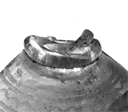Description
Despite its fragmentary condition, the shape and size of this engraved glass vessel identify it as a liturgical chalice. Comparisons to well-preserved silver chalices from the sixth and seventh centuries are numerous, though only one other glass example has survived, excavated at ancient Gerasa, in modern-day Jordan (Amman, National Archaeological Museum).
On one side, angels flank a jeweled cross inside a shrine. They hold books in covered hands signifying that the books are either Bibles or Gospels. The shrine is thought to reflect the monument in Jerusalem set up by Emperor Theodosios II (408–50) to commemorate Christ’s crucifixion on Golgotha. It was a major pilgrimage site, as the cross symbolized powerfully Christ’s triumph over death; worship there enhanced such a hope for all believers. On the chalice’s other, more fragmentary side, a man stands praying before a large jeweled cross. Between him and the cross is an omega, the last letter of the Greek alphabet; an alpha, the first letter, was no doubt placed between the cross and another praying figure of whom only the fingers are preserved. The letters refer to Revelation (1:8), “I am Alpha and Omega, the beginning and the ending, saith the Lord, which is, and which was, and which is to come, the Almighty.” The quotation attests to the Lord’s omnipresence and his return at the end of time for the last judgment.
The liturgical role of the vessel, supported by the images, emphasizes salvation through worship of the cross. Belief in Christ’s triumph over death and partaking of the Eucharist were expressions of faith in an afterlife and salvation within the community of Christianity.
- S. Zwirn
Bibliography
M. C. Ross, Bulletin of the Fogg Art Museum 9.4 (1941), esp. 72.
H. Swarzenski, "The Dumbarton Oaks Collection," The Art Bulletin
23 (1941): 77-79, esp. 78.
The Dumbarton Oaks Collection, Harvard University (Washington, D.C., 1955), 132, no. 266, fig. p. 137.
M. C. Ross, Metalwork, Ceramics, Glass, Glyptics, Painting, Catalogue of the Byzantine and Early Mediaeval Antiquities in the Dumbarton Oaks Collection 1 (Washington, D.C., 1962), 81f. , no. 96, pl. 54-55.
V. H. Elbern, "Ein christliches Kultgefäss aus Glas..." Jahrbuch der Berliner Museen 4 (1962): 17-41.
———, "Le calice de verre de la Collection Dumbarton Oaks," in Journées internationales du verre, Annales du 2e congrès international d'étude historique du verre, Leyden, 30 June-4 July 1962 (Liège, 1963), 55-67.
———, "Der eucharistische Kelch im frühen Mittelalter," Zeitschrift für Kunstwissenschaft 17 (1963, repr. Berlin, 1964): 1-76, 117-88, esp. 122, fig. 84.
———, Der eucharistische Kelch im frühen Mittelalter (Berlin, 1964), 125ff., fig. 84.
Handbook of the Byzantine Collection (Washington, D.C., 1967), 93, no. 319.
F. Dölger, "Beitrage zur Geschichte des Kreuzzeichens IX," Jahrbuch für Antike und Christentum 10 (1967), esp. 12-14, pl. 11b.
D. Barag, "Glass Pilgrim Vessels from Jerusalem: Part I," Journal of Glass Studies 12 (1970), esp. 42.
———, "Glass Pilgrim Vessels from Jerusalem: Part III," Journal of Glass Studies 13 (1971), esp. 62, fig. 54.
D. B. Harden, "Ancient Glass III: Post-Roman," The Archaeological Journal 128 (1972), esp. 81-82, pl. 5e.
J. Engemann, "Anmerkungen zu spätantiken Geräten des Alltagslebens mit christlichen Bildern, Symbolen und Inschriften," Jahrbuch für Antike und Christentum 15 (1972), esp. 163-164, pl. 10a-c.
K. Weitzmann, Age of Spirituality : Late Antique and Early Christian Art, Third to Seventh Century, ed. K. Weitzmann, exhibition catalogue, Metropolitan Museum of Art, November 19, 1977-February 12, 1978 (New York, 1979), 609-610, no. 545.
A. St. Clair, "The Visit to the Tomb: Narrative and Liturgy on Three Early Christian Pyxides," Gesta 18.1 (1979), esp. 132.
Cradle of Christianity, ed. Y. Israeli and D. Mevorah, exhibition catalogue, The Israeli Museum, Weisbord Exhibition Pavilion, Spring 2000-Winter 2001 (Jerusalem, 2000), 91.
G. Bühl, ed., Dumbarton Oaks: The Collections (Washington, D.C., 2008), 110, pl. p. 111.
H. C. Evans and B. Ratliff, eds., Byzantium and Islam: Age of Transition, 7th-9th Century. Metropolitan Museum of Art ed. (New York and New Haven [Conn.], 2012), 89, no. 55.
G. Noga-Banai, "Between Rome and Jerusalem; The Cross at the Center of a Herrscherbild Composition," Ikon: Journal of Iconographic Studies 5 (2012), esp. 61, fig. 9.
S. Lagabrielle, Le verre: Un Moyen A?ge inventif (Paris: E?ditions de la Re?union des Muse?es Nationaux, 2017), 24, ill. 14
Lourdes De Sanjose? I Llongueras. Al Servei De L'altar : Tresors D'orfebreria De Les Esgle?sies Catalanes, Segles IX-XIII. Primera Edicio?. ed. Barcelona] : [Vich]: Arxiu I Biblioteca Episcopal De Vic ; Patronat D'Estudis Osonencs, 2018: 43, fig. 11
Exhibition History
Cambridge, MA, Fogg Art Museum, "A Selection of Ivories, Bronzes, Metalwork and Other Objects from the Dumbarton Oaks Collection," Nov. 15 - Dec. 31, 1945.
New York, Metropolitan Museum of Art, "Age of Spirituality: Late Antique and Early Christian Art, Third to Seventh Century," Nov. 19, 1977 - Feb. 12, 1978.
Jerusalem, The Israel Museum, "Cradle of Christianity," March 16, 2000 - Jan. 30, 2001.
New York. The Metropolitan Museum of Art. "Byzantium and Islam: Age of Transition," March 14–July 8, 2012.









